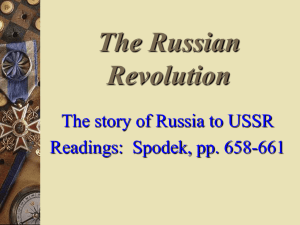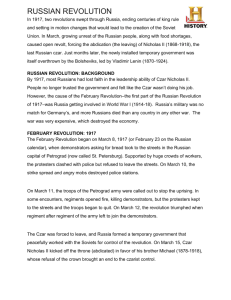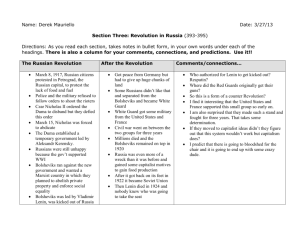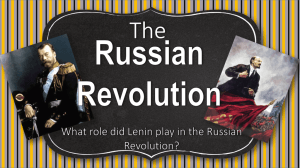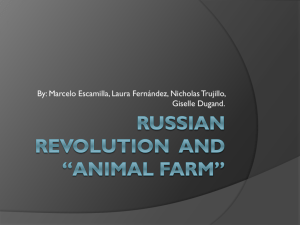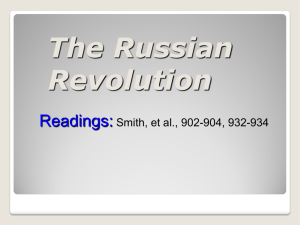RussianRevolution-1
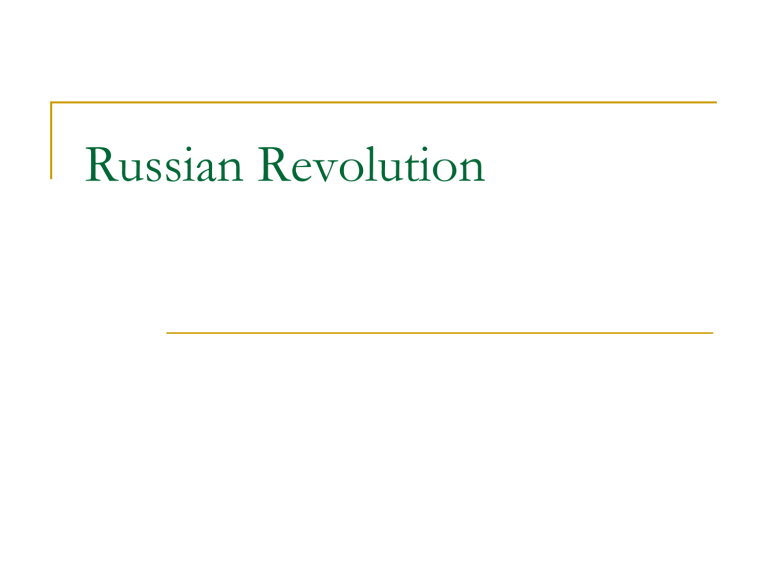
Russian Revolution
What was it?
1.
Actually TWO revolutions:
February/March of 1917 – overthrow of the Tzar
2.
October/November of 1917 – Bolshevik
(Communist) Revolution
Why Important?
1.
2.
3.
Led to Russia withdrawing from WWI to deal with internal problems.
“ Communism ” put into effect instead of just an “ idea.
”
Conflicting ideologies – communism vs. capitalism – was the reason for the Cold
War.
So what is Communism Anyway?
Communism is an ECONOMIC system.
Part of Karl Marx ’ s theory of economics.
Says that all the “ means of production ” should be owned by the government for the good of the people
– everyone “ owns ” everything and shares in the profits.
Nice ideas – no hunger, everyone works to the
“ best of their ability, ” and everyone gets just what they need.
Fails to take into account that we humans are greedy and lazy!
“ Intellectual Marxism ”
Karl Marx said that all of history is based upon economics (very good argument).
Marx saw an evolution of economics – hunting and gathering small farming manoralism commercial enterprise (small business) cottage industry (make stuff at home to sell) industrial revolution (so far, so good)
More Intellectual Marxism
Marx was living during the Industrial Revolution and what he saw was very disturbing.
Workers paid just enough to survive
Factory owners making huge profits and getting greedier
– how to make more money?
Longer working hours, same pay, poor working conditions, dangerous working situations – up to 40% of workers would be seriously injured or killed while working in a factory
Marx said that the working conditions and poor wages of the factory workers would not continue, that SOMEDAY workers would join together ( “ workers of the world unite ” ) and the proletariat would overthrow the owners and seize property to own jointly and to benefit EVERYONE
What does Marx have to do with Russia?
Very little – Marx said that first a country had to go through the Industrial Revolution –
Russia had not been industrialized and it was still a feudal society!
Russia had SOME factories, but 90% of the population of Russia were either serfs or peasants – they lived on the land – feudalism.
Wait! I thought the serfs were freed in
1861?
Technically they were; HOWEVER, they had to actually “ buy ” their freedom and they had
20 years to do so, BUT how can you pay for your freedom when you can ’ t leave your land and find a job? Oh, wait, there weren ’ t any jobs except on land and only peasants and serfs could work on the land!
How did some do it?
They fought in the army, but most of them died
– very high casualty rates!
So we have peasants and serfs and…
NOBLES – made up about 5% of the populations, were basically all related through one of eight noble families (Romanov,
Stroganov, etc.), and they owned about 80% of the land (and they are not selling it for anything).
What about the other 20% of the land?
Well, some serfs became peasants and did buy some land. These land-owning peasants are called Kulaks.
They got this land through the same law that freed the serfs – said if they could buy their freedom they also had 20 years to pay on a small piece of land.
The nobles aren ’ t giving up anymore land!
So why choose horrible communism? We know it doesn ’ t work!
We know because hindsight is 20/20, but it sounded good to 90% of the Russian population in 1917.
So they made this choice?
Land of Mickey
Mouse and
McDonalds!
Stand in long lines and hope to get items to survive!
Instead of…
No they made this choice…?
Utopia – everybody has something and no one goes hungry!
Living in abject poverty with no chance of ever advancing!
Let ’ s Get Back to the
Revolution
Nicholas I (1825-1855)
Was the third son of
Paul I
Was the Brother of
Alexander I, who died childless
Nicholas strove to serve country ’ s needs
– Good Czar
Alexander II (1855-1881)
Son of Nicholas I.
He came to the throne during the Crimean
War
Emancipated the serfs in 1861 – still a good
Czar
Alexander III (1881-1894)
Increased the repressive powers of the police
Limited the power of the local assemblies
Programs against anyone who was not
Russian
Sounds like a mean
Czar
Nicholas II (1894-1917)
Humiliating outcome of the
Russo-Japanese war led to
The Revolution of 1905.
Soon curtailed the Dumas
(parliament)
Decided to lead troops into battle during WWI – stupid idea by a stupid man.
In 1917, unrest continued and he had to abdicate
Bloody Sunday-January 22, 1905
Began in St Petersburg
Disaster of Russo-Japanese War revealed corruption and incompetence of czar
Octobrist Party
Constitutional Democratic Party
World War I/ Rasputin
Had control over the
Tsar Nicholas II and the
Tsarina
Was murdered in
December 1916
World War I was a disaster.
The Revolutions of 1917
February Revolution (March 8, 1917)
Czar Nicholas Abdicates
Then what happens?
For the next few months there is a “ president ” –
Kerensky – who rules and keeps Russia in WWI.
In April, VI Lenin arrives in Petrograd (St.
Petersburg) with the help of the Germans
Lenin believes the communist system could work in
Russia
Lenin calls for armed resurrection
October 16, 1917/November 6, 1917 (Russian
Calendar) revolution led by the Bolsheviks
(communists)
Lenin, Trotsky and Stalin are now “ in charge ”
What happens next?
Glad you asked – Civil War
Civil War broke out between two groups of
Marxists (Communists)
Bolsheviks (means “ majority ” in Russian, but in fact they had fewer members) – REDS
Menshoviks (means “ minority ” in Russian, had fewer members, but this is what the Bolsheviks called them, so it stuck) -- WHITES
What was the difference?
Politics – they both agreed on the economic system of government; however, should people be allowed to “ vote ” or should those most “ capable ” rule.
Lenin voted for the later and by 1920, Russia was firmly under his control.
Treaty of Brest Litovsk—
March 3, 1918
Lost 32% of the land
Lost Estonia,
Latvia, Lithuania
Much of the
Ukraine
Much of
Belarussia
Lenin didn ’ t care – this was a capitalist war
Civil War and Lenin ’ s Rule
From 1918-
1921
Reds
Whites
Creation of USSR
Nationalization of all land and banks
New Economic Plan
(NEP)
Lenin dies of a stroke
Power Struggle after Lenin ’ s Death and
Stalin ’ s Rule
Forced collectivization
“ The Great Famine ”
“ The Great Terror ”
Purges
Gulag
Winners and Losers
Winners
Communist Party
Some Workers
Massive Literacy Project — all those who learn to read and write
Vastly improved health care —all those who lived longer and healthier
Women
Losers
Poorest peasants
Traditional Russian upper classes
Many of those in traditional
Russian middle classes
Those killed or imprisoned because of oppressive regime
Jews, Muslims, other ethnic minorities
Romanovs – the royal family was killed, and their bodies were “ secretly ” disposed of – led to rumors of their survival
True communists
Democracy

